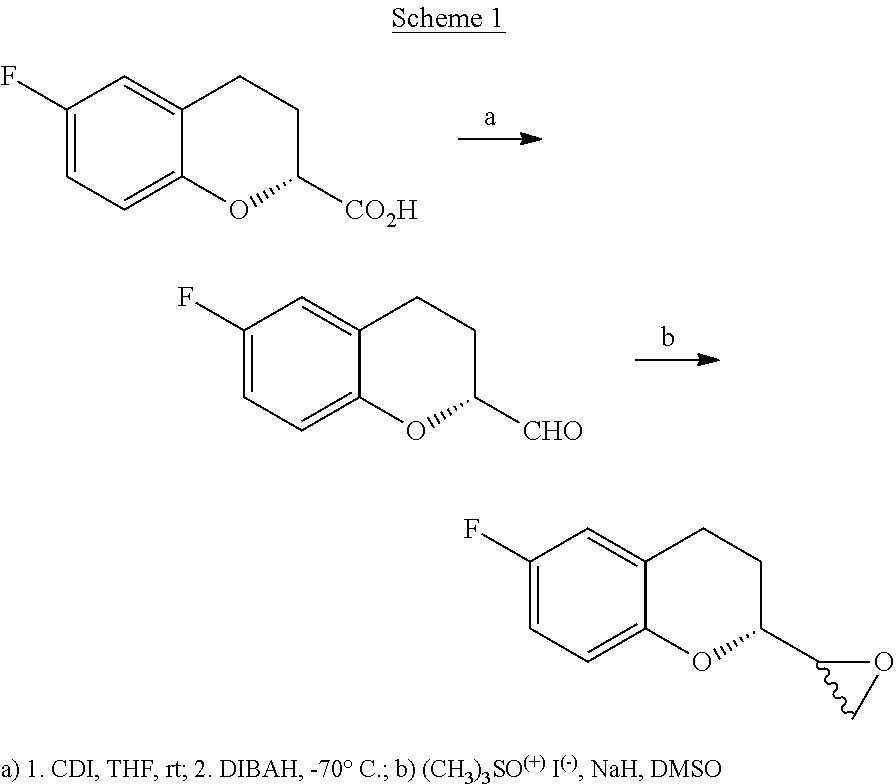Process for the synthesis of intermediates of Nebivolol
a technology of nebivolol and intermediates, applied in the field of synthesis of intermediates of nebivolol, can solve the problems of long and laborious sequence, low stability of obtained 6-fluoro-chromanyl aldehyde, and prone to racemization
- Summary
- Abstract
- Description
- Claims
- Application Information
AI Technical Summary
Benefits of technology
Problems solved by technology
Method used
Image
Examples
example 1
Synthesis of (R)-2-chloro-1-(6-fluorochroman -2-yl)ethan-1-one
[0089]
[0090]A solution of tBuMgCl 1M in THF (21 l, 21 mol) and a solution containing 1.6 Kg (7.2 mol) of carboxylated (R)-ethyl 6-fluorochromanyl IIa in MTBE (8 L) are added dropwise and at the same time to a sodium chloroacetate suspension (1.74 Kg, 15.1 mol) in MTBE (8 L) at 0° C. in a nitrogen atmosphere. The speeds of dripping of the two solutions are regulated so as to obtain a simultaneous dripping of the two solutions, also ensuring that the temperature remains in the range 3° C. / +3° C. during the entire course of the addition (1.5-2.0 hours). At the end of the addition of the reagents, the solution is kept under stirring at a temperature −3° C. / +3° C. After confirming that the reaction is complete by means of HPLC analysis, the suspension is added, dropwise, to a mixture composed of a solution of 50% H2SO4 (5.4 Kg), ice (17 Kg) and H2O (17 Kg), and is held at a temperature of −5° C., ensuring that the temperature ...
example 2
Synthesis of (S)-2-chloro-1-(6-fluorochroman-2-yl)ethan-1-one
[0093]The methodology described in Example 1 is applied similarly to the isomer carboxylated (S)-ethyl 6-fluorochromanyl IIb, resulting in an equal yield of the corresponding product (S)-6-fluoro-chromanyl chloroketone IIb.
example 3
Synthesis of (R)-6-fluoro-2-((S)-oyiran-2-yl)chroman and of (S)-6-fluoro-2-((R)-oxiran-2-yl)chroman
[0094]
[0095](R)-methyl oxazaborolidine ((R)-MeCBS) or (S)-methyl oxazaborolidine ((S)-MeCBS) (35.9 g, 0.129 mol, 3.3%) is added to a solution of BH3.DEA (0.70 Kg, 4.3 mol) in cyclohexane (8 Kg) under flow of N2, and the obtained suspension is left under stirring at ambient temperature for 15 minutes. The chloroketones IIIa or IIIb (0.9 Kg, 3.9 mol) are added, respectively, to such a reducing mixture in portions of 45 g / 10 minutes. After 20 minutes following the last addition, the HPLC analysis reveals the almost total disappearance of the starting product (6-fluoro-chromanyl chloroketone2SO4 1M (7.5 Kg), then with H2O (2×8 Kg), and the solvent is removed at reduced pressure so as to obtain, respectively, (R)6-fluoro-2-(S)oxiranyl chroman (Ib) or (S)6-fluoro-2-(R)oxiranyl chroman (Id), with a yield for the two steps equal to 90%.
PUM
| Property | Measurement | Unit |
|---|---|---|
| temperature | aaaaa | aaaaa |
| temperature | aaaaa | aaaaa |
| temperature | aaaaa | aaaaa |
Abstract
Description
Claims
Application Information
 Login to View More
Login to View More - R&D
- Intellectual Property
- Life Sciences
- Materials
- Tech Scout
- Unparalleled Data Quality
- Higher Quality Content
- 60% Fewer Hallucinations
Browse by: Latest US Patents, China's latest patents, Technical Efficacy Thesaurus, Application Domain, Technology Topic, Popular Technical Reports.
© 2025 PatSnap. All rights reserved.Legal|Privacy policy|Modern Slavery Act Transparency Statement|Sitemap|About US| Contact US: help@patsnap.com



